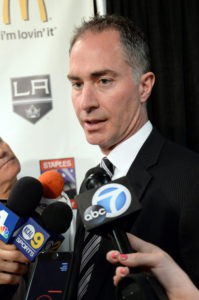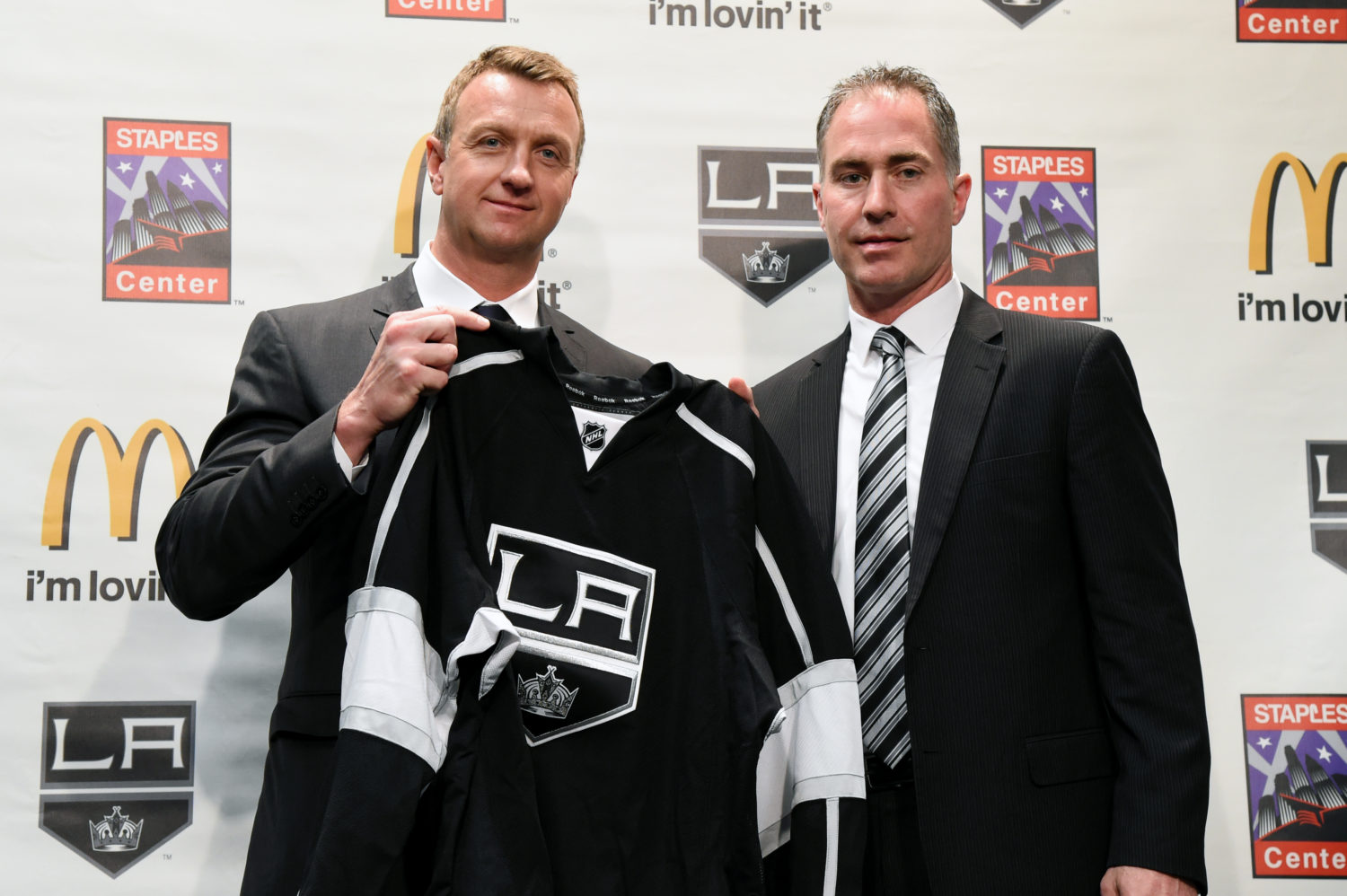
Andrew D. Bernstein/NHLI
“I’ve heard the word ‘search’ for a long time. There was literally no search,” General Manager Rob Blake said. “I went to John as soon as the changes were made and expressed our interest, and we sat and kind of went over a game plan as a review of last year, but also some of the things John has touched on offensively – the style of the game that’s being played, the direction of the game and what we could accomplish to suit that, and the details on the offensive front that would be installed. That’s taken place pretty much for the last 10 days or so, but again, that was a decision made early and we went forward with that.”
Citing Stevens’ honesty in his approach to the game both as a player and as a coach, Blake praised the work ethic and preparation that has helped lead the club to success. Stevens was an assistant coach with the team during the 2012 and 2014 Stanley Cup runs before a promotion to Associate Head Coach. Blake said he saw such dedication “first and foremost firsthand.”
“The honesty factor goes a long, long way,” he said. As noted, the conversations surrounded the implementation of the game plan, the team’s systems and the direction of the game, which according to both general manager and head coach, and plenty who pay to enter NHL arenas, as having sped up in recent years.
That comes, according to Stevens, in an evolution of the transition game in the NHL.
“Just the pace of the game, transitioning from one side of the puck to the other, to me, is as fast as it’s ever been,” he said. “If you look at the defenseman in the game – we actually looked at this in ’07-08 when I was in Philly – there were two teams in the league that had three 30-point defenseman. The entire league. We were one and Detroit was the other. This year there were six teams that had three 30-point defenseman. There were three more teams that just had two 30-point guys and one or two other guys that had 28 or 29 points, so it’s close to nine teams with three 30-point defenseman, where it was two 10 years ago. So clearly getting up and down the ice with five people is a real focused part of the game and the ability of the defenseman is a real focus of the game, and quite honestly, it’s something we’ve trended towards here with the Kings.”
And therein lies the nuance. Hockey isn’t SPEEDPUCK. It’s not simply the fastest teams that win year-after-year. If that was the case, we’d be talking about the back-to-back-to-back-to-back-to-back New York Rangers Stanley Cups over the Colorado Avalanche, Edmonton Oilers and Minnesota Wild. Even when many were pointing at Pittsburgh’s speed as their defining characteristic last season – and yes, the Penguins were explosively fast – they were still, at heart, a team that forechecked relentlessly and pinned their opposition deeply back in their opposing end. For as much as their run last year was about speed, it was also about structure and the ability to force opponents into grueling zone exits. Their third and fourth lines also had speed and skill, an important component in the modern game.
When the Kings have operated at their most bought-in, they’ve adhered to many of these concepts, especially the ones based on structure, forechecking and positioning. They weren’t as fast individually as the Penguins, but they moved the puck quickly from the defensemen to the hands of the forwards in playing with a brisk pace.
“Quite honestly it’s something we’ve focused on and it’s something we’re going to continue to focus on,” Stevens said. “It’s something we want to be better at and we think it’s something important. If you can be big and fast, it’s better than big and slow. And we want to be big and fast. We want to be big and fast with the puck and we want to be big and fast without the puck and make sure that we have it more. And the big thing is we want to reward our work more by having it more and making sure we end up in scoring areas more.”
“Big and fast” is a good goal to set. The Washington Capitals are big and fast. The San Jose Sharks, last year’s Western Conference Champions, are big and fast. The Anaheim Ducks are a team that has always been a big, physical club that has recently benefited from a young infusion of skill and speed from players like Rickard Rakell, Brandon Montour and Shea Theodore.
Los Angeles also sorely needs an infusion of skill, and could also benefit from generating more speed from its depth assortments, but “big and fast” should be this team’s template towards success, and Stevens understands that.
“Well, I don’t know if I can tell you there’s a button we’re going to push and it’s going to change everything,” he said. “I think we do an awful lot of good things here, and I do think the game has changed a little bit. And we’re certainly paying attention to that. The mobility of defense in the game now, the speed in which teams transition the puck is certainly areas that we’re going to try and get better at. And we do want a team that attacks hard to the net and it’s not that we haven’t done that before, but it’s something that we’re really going to focus on.”
The Kings will also look to find success by carrying the puck down the center of the ice. I’ll have more on this shortly, but Los Angeles will strive to be a team that does more with its offensive zone entries and will look to generate more from down the middle.
“I think part of our identity as a hockey team has to be that the LA Kings are a team that goes hard to the net, and quite honestly, if we lead the league next year in coaches challenges for goalie interference, I’d be really happy about that,” Stevens said.
John Stevens, on where he differs from Darryl Sutter as a coach:
That’s a good question. I think Darryl’s one of a kind. He’s an awesome man and an awesome coach and he’s got a tremendous amount of experience, both playing and coaching the league for a long, long time. They didn’t hire me here to be Darryl or not be Darryl. I’ve been here for seven years and they know my personality. I think everybody’s personality is different and that’s just the way it is. I think it’d be really hard to find two coaches that are exactly the same, but I think we have a lot of similarities in that we’re very driven to win. We both put the team first in a lot of ways, but I just think the fact that we’re different personalities. I have two kids, John and Nolan, and I love them both dearly and they’re really, really different but really, really awesome kids. I think they’re hiring me to be John Stevens because they know I am. They know my personality. They know how I interact with players and it’s nothing against, to compare to anybody else – it’s just the decision we made at this time.
Stevens, on how much of the coaching change was a response to a changing philosophy in the NHL:
I don’t know. That’s just the nature of our business, to be honest with you. I don’t think there’s any deeper reason than that. If Darryl decides to coach again somewhere else, I would bet a lot of money he’d be really successful. So I just think it’s part of our business. If you look, I don’t think there’s any team in the league who can sustain two down years and we’ve had enormous success here. Even Chicago’s searching for answers and they’ve been the most impressive team in the league the last 10 years, so I just think it’s the nature of our business and we get into this and we know that’s the deal. I knew that in Philadelphia when I got let go. We’re excited for these opportunities, but we know what we’re dealing with.


Rules for Blog Commenting
Repeated violations of the blog rules will result in site bans, commensurate with the nature and number of offenses.
Please flag any comments that violate the site rules for moderation. For immediate problems regarding problematic posts, please email zdooley@lakings.com.